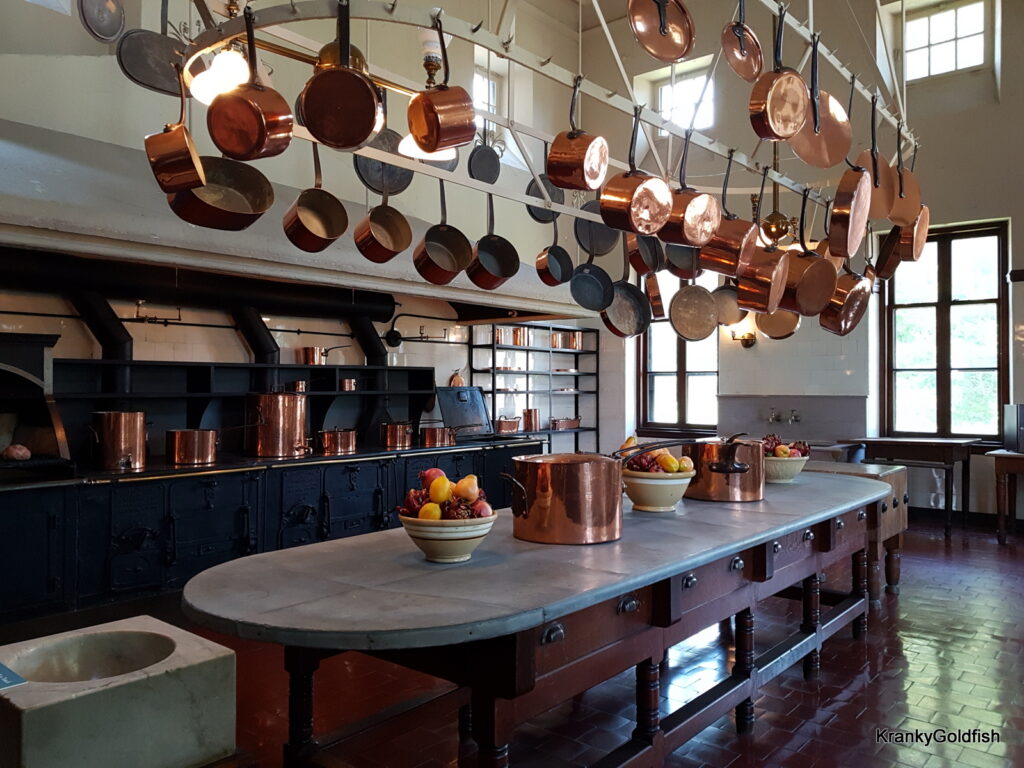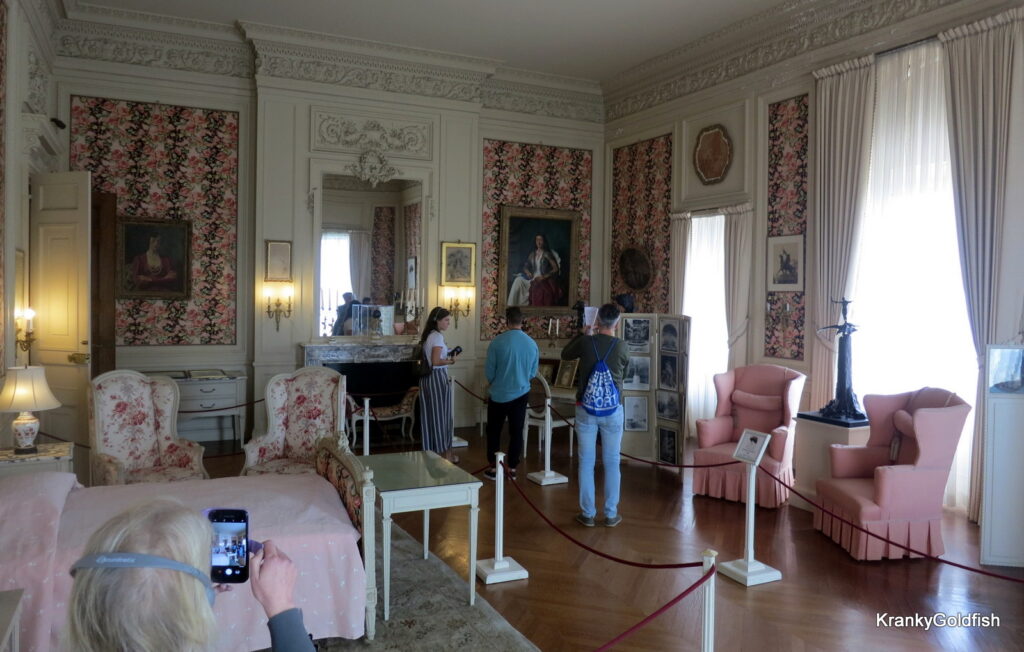Day 11. Swansea to Portland
In which we see how crazy rich Vanderbilts used to live and drive through four states! in a single day.

This morning we rose early and after a cheering breakfast – seriously, an egg and bacon toastie and a cup of coffee and I can face just about anything – we climbed into The Mighty Sentra and drove down to Newport. Too early, in fact, because we misread the opening time for The Elms and arrived an hour early.
Ah well. We wandered down to the waterfront at Newport, summer playground of the rich and richer, and looked at shops and boats. It was about 10am on an overcast Saturday morning and surprisingly little was happening.

And we had only meant to have a quick look at The Elms, so by the time that house actually opened we needed to head off to The Breakers, where we had a tour booked to attend.

The Breakers is the mack daddy of Gilded Age mansions. It was built in about 18 months in 1893-1895 after the previous building here burnt down in late 1892, and served as the summer house for the Vanderbilt family for about 40 years.

The Gatehouse was the residence of the property manager. Even though the family only lived here for 10-12 weeks each summer, there was a maintenance staff of a dozen or more year-round.
The Gatehouse was also where we started our tour. Beneath the Breakers takes small groups on a guided tour downstairs to the cellars and beyond. Because the previous house had been destroyed by fire, Cornelius Vanderbilt II required the new house to be as fireproof as possible. It was built with a steel frame and the building’s boilers were located under the Gatehouse, nearly a hundred yards from the house proper. Piping carried steam and hot water from there to the house through a series of tunnels and rooms. As well as the coal storage and boilers you can see the original (and still functioning) 1899 fuse box from when the house was electrified.




Also under the house was the wine cellar. The family held extravagant balls and parties frequently during their short summer stays, and brought a complete cellar full of wine each year when they came from New York. When they stopped their annual visits in the 1930s, the remaining wine was just left behind.
Or so the story goes. Sceptical Dave thinks that at some point, the remaining maintenance staff would probably have gotten in there. “Just making sure it hasn’t spoiled, boss.” But, it’s a good story.
The tour took less than an hour and gave some fascinating insights into the infrastructure that kept the great mansion running. Tickets are USD18 as at the time of writing and we strongly recommend it.

The Breakers is just breathtaking. It is a glorious statement of excess and wealth that stands out in a period that was known for excess and wealth. The Vanderbilts in the late 1800s were among the richest people in America, with a family fortune built from shipping and railroads. Cornelius took the building of the new mansion as a challenge to create the most opulent, luxurious and modern house imaginable.
And he succeeded.

The fun starts in the entrance hall. It stretches the height of the first and second floors, maybe fifty or sixty feet? Marble tiles, ornamental carvings as far as the eye can see. I mean, just assume I write that at the start of every paragraph, because it’s true everywhere.
It’s a level of ornamentation that to our modern tastes seems ridiculously over the top. But it was the style at the time.





I have to admit, I find it almost impossible to imagine living in a place like this. The scale, the grandeur, the impracticality, are all just beyond me.
In my internal visualisation of life here, I’m not living in the fancy bedrooms, or dancing in the fancy ballroom.

Nope, I’m here in the kitchen, making the snacks.

One of the bathrooms. Possibly the least ornate of the rooms (apart from the servants’ quarters of course), and even almost tasteful by modern standards. But what’s that little floor-level basin for at the right? If anyone knows, please tell us.

The baths at The Breakers famously had multiple water sources available, and taps to match. Public health and disease were big issues in the late 19th century – two of Cornelius’s children had died very young – and the Vanderbilts didn’t really trust the Newport municipal water system of 1894 to deliver uncontaminated water to their standards. So rainwater was captured, and seawater was pumped up from the Atlantic below the cliffs, and bathers could take their pick.

Gertrude Vanderbilt’s bedroom. Cornelius’s and Alice’s daughter, in her late teens when the house was built, she went on to a career as a respected sculptor. The bedrooms are almost on a human scale.

A loggia at the rear of the building looks out over the Atlantic. Below the edge of the lawn are cliffs, at the base of which beat the breakers for which the house was named.

The gardens of the house are also beautiful and well worth allowing time to look around. Interestingly little of the gardens are original; they were almost entirely destroyed in the great hurricane of 1938.
So that’s The Breakers. The Vanderbilt family used it regularly for less then 40 years, as Cornelius died in 1899 and after his wife Alice died in 1934 the next generation were unwilling or unable to spend the time and money to maintain the house and the lifestyle associated with it. When property taxes were introduced in the 1930s the estate became a financial burden to the family, and in 1948 it was leased (and later sold) to the Preservation Society of Newport County who keep it and numerous other mansions open to the public. The family has an enduring right of residence, and a few descendants have apartments to this day on the third floor, which was originally rooms for visiting friends and servants*.
It was a great visit; we spent probably three or four hours there and wish we had time for more.
* The family and any guests brought their servants with them of course. The third floor had quarters for thirty servants, with the rooms double-stacked with 9-foot ceilings** compared to the 18-foot height of the floor as a whole.
** If that sounds pokey, it’s still higher that the 8’6″ which is the minimum height for a room these days.

So it was back into The Mighty Sentra and north to Portland Maine, our destination for the night.
Mostly we were just motoring up the I-95, which is like driving on any big modern freeway not in an actual city. Good road, smooth traffic flow, kind of boring. I will say that as a driver from Australia, the land of traffic cameras, the behaviour of American drivers was a bit of a shock. Speed limits in the US seem to be more of a guideline than a rule. Driving at the speed limit (which I, of course, unfailingly did) results in everyone else leaving you in their dust. Ten miles-per-hour over the limit seemed pretty normal, and fifteen was not unusual. Which given that some sections of the I-95 have a 75 mph limit meant that some drivers (definitely not me) were scooting along at about 90 (which is 140 kmh in Australian).
I toyed with the idea of driving through some of the coastal towns north-east of Boston, some of which are the inspiration for H.P. Lovecraft’s fictional Innsmouth, but alas time was not on our side.
And so we passed quickly – very quickly – from Rhode Island through Massachusetts and New Hampshire to Maine, arriving in Portland a little before dusk. Four states in one day! Though they are smallish states, and honestly New Hampshire was a quick in-and-out. But I’m counting it.
We checked into the Holiday Inn for our two nights in town, and wandered down to the main street for a quick orient and stroll. As dark fell we stopped in Gritty’s for a nice casual pub meal. Gritty’s is a brewpub and we had some fine local beers and ciders as well as tasty food.



And so back to bed. The ten minute walk uphill to the hotel was good for our character, and a handy leg-stretch after a long drive.
Tomorrow, we get our tourist on in Portland. No, not that one. The one on the right-hand coast.